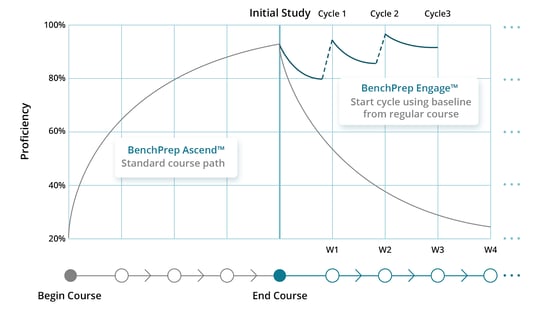4 Tips for Fostering Learning Culture + Secrets to Continuous Learning
Workplace training has developed a bad reputation. Many programs involve long sessions focused on compliance and regulations.
Employees can dread such sessions and don’t see how it’s applicable for their day-to-day roles. But, you know the importance of your team not only completing their required trainings, but retaining the knowledge. One way to keep learners growing is by making the switch from a training culture to a learning culture.
But what’s the difference?
In a training culture, people assume that employees learn skills at designated workshops. But a learning culture celebrates, rewards, and encourages consistent learning.
For L&D to impact team development, they must foster a learning culture.
Moving from training culture to learning culture
Culture ultimately drives behaviors, shapes relationships, and impacts overall success. Here are four steps to take to switch from a training culture to a learning culture.
1. Align with leadership.
In a successful learning culture, L&D stakeholders and executives are on the same page. More than 50% of executives suggest that L&D teams aim to tie learning to business outcomes.
When leaders prioritize learning, employees work harder and have a stronger sense of accountability. In fact, 94% of employees say they would stay at a company longer if it invested in their career development.
L&D teams should educate higher-ups on the benefits of retaining proficient and dedicated employees. Then, alignment will be easier to achieve.
2. Encourage manager involvement.
Managerial mentorship can have a positive effect on employee development and motivation. To foster a learning culture, managers should actively encourage continuous learning.
Like any other business endeavor, managers should model the behavior they want to see in their employees. They should take part in continuous learning themselves and ask employees about their learning progress in reviews.
This is important because 56% of employees agree they would spend more time learning if their manager directed them to a specific course in order to gain or improve skills.
It might mean time away from their desks. However, inspiring employees to attend networking events, sign up for courses, or actively participate in social learning activities will create an atmosphere of support, respect, and growth.
3. Don't disregard soft skills.
Vocational skills require technical training for someone to do their job effectively. Soft skills are less tangible and include communication, collaboration, and time management.
Teaching and driving positive behavior is extremely valuable in developing long-term, professional employees who managers can trust to react, perform, and represent an organization well.
Today, teaching soft skills is considered a top priority for organizations as 92% of executives say soft skills are equally important, if not more important than technical skills. Adding soft skills to your learning curriculum creates well-rounded employees.
4. Incorporate technology.
Investing in a learning platform can help L&D teams manage, personalize, track, and scale learning activities. Across the board, talent developers, executives, and even employees agree that making time for learning is the #1 challenge.
A digital solution can make it easier for everyone to access learning material in one, comprehensive destination. Just remember that a learning culture won’t be built overnight.
Strong learning platforms provide data and analytics to help L&D uncover powerful insights. These insights help L&D evaluate strengths of the program, assess employee engagement, and measure performance.
This can ultimately be tied back to the goal at hand: to create a learning culture.
BenchPrep's mission is rooted in helping organizations build strong learning cultures.
Ready to make the change? Learn more about our learner success platform.
The above tips will ease the transition from a training culture to a learning culture, but there’s one more essential ingredient: continuous learning.
Why Continuous Learning Is Essential To A Learning Culture
We’ve all been there—the conference presentation that should have been labeled “information dump” or “you could have just read the book.”
We know it takes time to learn anything proficiently. Yet, we live in a world promising us “quick tips,” “top secrets,” or “life hacks.”
Unsurprisingly, one-day training sessions or short courses often yield lackluster results. Who has time for poor results with the ever-increasing pressure to deliver a great ROI?
There is a better way—continuous learning.
How Does Continuous Learning Work?
Just like the name suggests, learners continually review material until they reach mastery. Unlike traditional learning, no one sets an arbitrary exam date or deadline.
Instead of being given a percentage representing how much you understood, you continue working until you’re batting 100.
In continuous learning, learners will take a diagnostic assessment first and then follow a personalized learning plan until re-assessment. Ideally, they repeat the cycle with a new personalized learning plan focusing on whatever they need to master.
BenchPrep’s comprehensive digital learning platform automatically generates a personalized learning plan for users. We believe everyone deserves to feel confident in their learning, not just a good grade.
Why Continuous Learning Works With Your Brain
Your brain isn’t a computer. It doesn’t memorize on-command. Instead, your brain creates networks of neurons to make deep memories.
Spaced repetition, when you review material periodically, allows your brain to make memories. Knowledge retrieval, like answering practice questions, also promotes retention.
People forget anything they learn in a class in a matter of weeks. Scientists call it the forgetting curve.

Why Is The Forgetting Curve Important?
Whether you aced an exam on the state capitals in the third grade makes no difference in your adult life. Can you say the same for your professional life? For the construction worker building a house? For your doctor’s professional decisions?
Failing to learn can have disastrous consequences. In fact, medical errors are the third leading cause of death in the US.
Can we reduce life-threatening errors with better training?
Of course we can. Continuous learning provides the answer because learners keep going until they reach a high level of proficiency.
Today, it’s easier than ever to implement a continuous eLearning platform. Many providers can push bite-sized learning modules to mobile devices daily.
In less than 5 minutes a day, learners keep their skills sharp by answering a few questions and receiving immediate feedback.
Implementing a culture of continuous learning can also improve learner engagement. Here are 5 tips to show you how.
5 Tips to Improve Learner Engagement with Continuous Learning
1. Personalized Learning Plans
Online continuous learning platforms generate personalized plans to keep learners engaged. Then, learners are always at their “just right” level.
In a personalized plan, you’ll understand the concepts, but still be challenged. Learners “test out” of any content they’ve already mastered. Now, they’re never bored and they’re constantly upskilling.
2. Adaptive Learning
Adaptive learning takes personalized learning one step further. Personalized learning uses a pre-test at the start of a course. Adaptive learning focuses on improving your learners’ experience and performance during the course.
The program adapts to push learners on the material they haven’t mastered yet. Learners also stay more engaged because they’re not reviewing the information they’ve already learned.
3. Microlearning Modules
Continuous learning requires microlearning content to fit into a professional’s busy schedule. Luckily, microlearning boosts engagement.
A survey by Software Advice found 58% of employees were more likely to engage with shorter learning modules. Microlearning helps reinforce mastery of your course content by continuously serving your learners with daily material.
This allows instructional designers to scaffold material more effectively and test more frequently to fix any misunderstandings.
4. Progress Tracking
Research suggests people feel happiest when they’re making progress. Continuous learning allows learners to see their growth over time.
For example, Duolingo makes this progress very clear by tracking which modules learners have mastered or not. They’re also able to unlock more difficult lessons as they progress.
By making progress visible, learners receive psychological boosts to keep them engaged.
5. Push Notifications
Continuous learning has an automatic leg up over traditional LMS software—you can push it to a user’s mobile device. Research found adults check their phones an astonishing 96 times per day or once every 10 minutes.
Proliteracy also found reminder notifications increased attendance for in-person classes by over 25%. Imagine what the increase will be for 2-5 minute microlearning modules you finish right on your smartphone?
The BenchPrep Approach
We use continuous learning as the research basis for BenchPrep Engage. This platform pushes daily questions directly to learners’ phones. They answer a quick question, then they get immediate feedback.

Continuous learning keeps learners engaged because they receive just-in-time, relevant information daily. We also use confidence-based learning in our program because research shows confident learners make better decisions.
This platform will continue to push questions to learners until they report a high level of confidence for the whole course, not just the 60% they got right on the final exam.
BenchPrep Engage solves the problem of how to keep learners on your platform after they’ve completed an exam. With engaged learners, you’ll continue to grow your revenue long after the training is done.
Download our ebook to learn why high-stakes learners need continuous learning to achieve mastery—and what you can do about it to grow revenue and improve learning outcomes.

.png)




